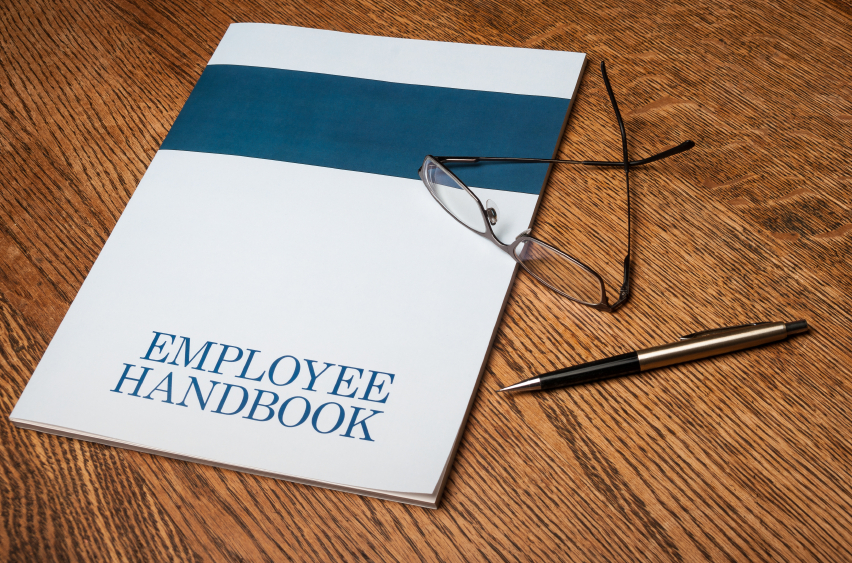YOUR MOST EFFECTIVE COMPLIANCE & COMMUNICATION TOOL: YOUR EMPLOYEE HANDBOOK
An employee handbook is more than just a collection of workplace policies. An up-to-date and clearly written employee handbook is an important risk management and workforce communication tool. It promotes consistency in the application of company policies, ensuring fairness and reducing the risk of claims. It provides employees with a clear understanding of what they can expect from the company and what the company expects of them.
However, it’s often the case that the employee handbook is drafted, distributed, and forgotten about. It’s always on the list of things to review and update, but frequently gets set aside for other, more pressing projects. This not only presents a risk that your policies may no longer comply with legal requirements, but also that our employee handbook may no longer fit your company or how your employees work.
It’s important for employers to take the time to carefully draft their employee handbook, ensuring it contains essential policies and is tailored to the business, and review it regularly to ensure it remains compliant and consistent with the evolution of their business.



Ensuring Legal Compliance & Avoiding Common Errors
Regardless of the size of the business, having an employee handbook that is current and compliant is essential. Employee handbooks communicate company values and workplace rules, answer common employee questions, establish performance and behavior expectations, and, if up-to-date and clearly written, protect the business in the event of a claim.
What are the Essential Policies?
Company size, industry, geographic location, and company culture will dictate many of the policies that are included in an employee handbook. Policies should reflect legal obligations as well as the core values and priorities of the business.
There are common policies that every handbook should include, if applicable:
- Welcome Statement and Mission Statement
- At-Will Employment
- Equal Employment Opportunity and Anti-Harassment/Discrimination
- Pay Practices, Hours of Work, and Timekeeping Practices
- Employee Benefits, like Employer-Offered Insurance and Retirement Plans
- Leave Policies, including Holidays and Mandated Leave Requirements
- Expectations of Employee Behavior, Appearance, and Code of Conduct
- Discipline, Termination, and Grievance Procedures
- Safety Procedures, including Drug & Alcohol Testing, Workplace Violence, and Emergency Response
While employers must ensure that their employee handbook covers all key company policies, it cannot and should not include every conceivable policy. Employee handbooks that are overly inclusive are less effective because it becomes difficult for employees to distinguish essential information from everything else.
Avoid Treating Your Handbook Like a Contract
The primary purpose behind an employee handbook is to educate employees on company policies and workplace expectations. It is not an employment agreement. While an employee handbook is not a contract, careless language can create ambiguity.
Employers should be mindful to avoid language that makes promises or guarantees that could be interpreted as binding commitments. For example, a statement that employees must maintain satisfactory performance to remain employed or that accrued unused vacation time will be paid out upon termination. While those statements may be true, without qualifiers or disclaimers, they can also be interpreted as contractual obligations.
Further, incorporating contract provisions, like non-compete clauses, liability waivers, or indemnification/hold harmless clauses, into an employee handbook blurs the lines between what is contractual and what is merely a guide. To avoid having an employee handbook treated like a contract, keep policies and contractual terms separate.
Maintaining At-Will Status
Most employment relationships operate on an at-will basis. That means that the employer or the employee can end the relationship at any time (with or without cause) and for any reason (or no reason at all) as long as it is lawful.
Employers should clearly state that the employee handbook does not change the at-will employment relationship. They should also ensure that other policies do not undermine the at-will employment relationship. For example, probationary periods that make it appear that employment is guaranteed for a specific period, or progressive discipline policies that fail to state that an employee can be terminated at any time.
Employers can include language in their employee handbook to further emphasize the at-will employment relationship, including:
- Written or oral statements are not to be interpreted as altering the at-will relationship
- Disciplinary procedures may be adjusted or modified at any time and at the company’s discretion
- The employer reserves the right to change any terms or conditions of employment, whether these are stated in the handbook or established through employment practices
- The terms and conditions contained in the employee handbook can only be altered in writing and signed by specified officers of the organization (e.g., owner, president or CEO)



Tailor Your Employee Handbook to Your Business
One size does not fit all when it comes to employee handbooks. While a template can be helpful to ensure the right structure and inclusion of essential policies, an employee handbook should be tailored to align with the company’s culture and business operations.
Company size, industry, geographic location, and company culture are relevant not only to what policies will be included in an employee handbook, but also to the structure and tone of the employee handbook. Does the organization have remote workers? Are there industry-specific requirements that employees need to be aware of? Is the company a start-up or an established business?
No two businesses are alike, so their employee handbooks shouldn’t be either.
Keeping Your Employee Handbook Up-To-Date
Lastly, but maybe most importantly, employers need to ensure their employee handbooks remain current. An employee handbook is not a static document. It should evolve as the business evolves.
Regular reviews of the employee handbook are crucial to ensure it remains compliant. We recommend that employers review and update their employee handbook on an annual basis at a minimum. However, if major legal changes occur, employers may need to update their employee handbook on a more frequent basis.
Outside of compliance, regular reviews of the employee handbook allow employers to remove any inconsistencies in and between policies and ensure it adequately covers any changes in the business. The employee handbook that was implemented when a business had 15 employees working in one location is no longer going to cover a business that has grown to 100+ employees with locations in multiple states.
Anytime there is an update to the employee handbook – whether small or major – it’s important to communicate the change to employees to avoid confusion. For significant changes, employers can have all employees sign another acknowledgment form that verifies that each employee understands and accepts all changes to the handbook.
Conclusion
An employee handbook is far more than a comprehensive collection of rules; it’s a dynamic and indispensable tool for managing risk, ensuring compliance, and fostering clear communication within your workforce. Whether an employer is drafting an employee handbook for the first time or revamping an existing one, by following the best practices outlined in this article, employers can better ensure that their employee handbook promotes consistency throughout the employment relationship, protects the organization, and stands up to the demands of today’s workplace.
By: Audra L. Parton, JD
Need help with your employee handbook? Whether you are starting from scratch or looking to update the employee handbook you already have, NAE can help.
All NAE members have access to our sample employee handbook template, available for download in our Member Portal, to use as a general guide and framework for drafting or updating their own employee handbook.
Too busy to do your annual employee handbook review? Our team of HR and legal professionals will conduct a comprehensive review for you and provide you with recommendations for updates and edits to keep your handbook current and compliant. All NAE members can take advantage of this included membership benefit on an annual basis.
For businesses that need more hands-on assistance in developing their employee handbook, NAE offers member organizations employee handbook drafting and updating services for an additional hourly fee. Let our team of experienced professionals take on the task of drafting or updating your employee handbook for you.
Contact NAE at info@nevadaemployers.org for more information on how to take advantage of these membership benefits.
Mailing List Sign Up Form
Fill out this mailing list sign up form to receive monthly email updates on the latest NAE news, HR issues, special events, training dates and more!
